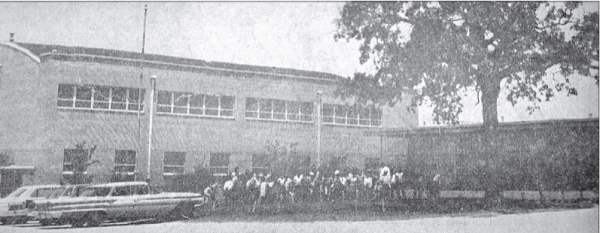




Milam County Historical Commission
Milam County, Texas
All credit for these articles go to
Susie Sansom-Piper and
the Rockdale Reporter
Milam County, Texas
All credit for these articles go to
Susie Sansom-Piper and
the Rockdale Reporter

index to Black History month articles
Written by Susie Sansom-Piper and
published in the Rockdale Reporter
Written by Susie Sansom-Piper and
published in the Rockdale Reporter
ON THE OTHER SIDE OF THE TRACKS - SERIES 9 PART 4
Editor’s note: This is the fourth article in the ninth series of “On the Other Side of
the Tracks,” a Black History Month series by former Rockdale resident, and longtime
teacher, Susie Sansom-Piper.
60S Bring Changes to Both Sides Of The Tracks
By SUSIE SANSOM-PIPER
Reporter contributor
The community on “the other side of the tracks” continued to thrive.
Along with improvements to the city as a whole, new churches were built to replace the
aged, worn churches, and the Rising Star Church building was moved from the Sharp
Community to Rockdale.
The new Aycock School was built on Baxter Street in 1954.
GLORY DAYS — Aycock students, under the leadership of Prof. O. E. Wilhite, Sr., and his
18 faculty members, continued to pursue their championship quest for the next 13 years.
There were many state winners in football, basketball, track, typing, home economics,
debates, spelling, vocal music, band, and public speaking.
Also, Aycock’s era of professional athletes, Frank McKee, Billy Ray Locklin and James
Leroy Wright had arrived.
James Banks Jr. made special history in becoming the first baseball player in this region
to pitch a no-hitter, and Annie Bell Page made history in girls’ basketball.
Even after graduation, Aycock students achieved greatness:
Bob Roberson, first black to head the Postal System in Arizona;
Lee Alcorn, politician and radiologist Specialist.
Award-winning educators Fannie Lovelady, Barbara Sansom, Margaret Sanders, Sharon
Williams, Bobbie Nell Richards, Margaret Banks, Johnnie Black, Gladys McKee, Johnnie
Sanders, Fred Wilhite, O. E. Wilhite, Jr., Emma Douglas, Ethel Green, and Delores
Phillips.
Nurses Eula Sansom, Lora Turner, Pearlie Haynes, Estell Fair, Alyce Sanders, Mae Joyce
Jackson and Allie Banks.
Patricia Jones, medical researcher; Lon Williams, Banker; Elma Moultrie, postmaster in
Manchaca, Texas; Lucy Ray Crawford Billy Gray, and Billy Joe Douglas, Business Owners.
Lovie Molden, sheriff; Bettie Miller, Daisy Majors, Marie Moore, Hope Cooke, Clara F.
Clark, secretarial work.
Lawrence Bacy, minister; Dennis Brooks, minister and founder of school of religion. Those
who did not pursue colleges were all successful in their chosen line of work.
CHANGES — The Civil Rights Acts, the many protests, riots and other rivalries changed the
complete outlook for Blacks and Whites, especially in most of the Southern States.
Disturbances were rampant, and many people lost lives. Yet, on the other side of the
tracks, there were no violent reactions, only verbal discussions among friends and
neighbors.
Although, many negative things were often expressed, everyone obeyed the laws of the
land.
FINAL DAYS — The final days of a great school ended with the graduating class of 1965.
This class included Jessie Brooks, Gloria Nell Crawford, Arthur Ray Dykes, Curtis
Johnson, Bertha Mack, Patricia McDaniel, Bettie Jean Miller, (valedictorian), Joyce
Nealy, C. Anthony Norwood (salutatorian) and Doris Robertson.
Aycock sixth grade was sent to Rockdale Middle School, including teacher, Flora J. Mack.
The remaining middle and elementary students were given “freedom of choice” to integrate,
or to remain at Aycock.
In May 1967, four teachers — Lucy Battle, Ardie M. Williams, Frankie McDonald, Susie E.
Sansom — and 51 students gathered under the giant oak trees north of the Aycock Gymnasium
for a farewell picnic.
LEGACY — Thus ended the annals of Aycock High School, for post-integration, all students
attended the schools on the northern side of the tracks.
A new Rockdale High School was built in 1955.
The old high school, which was built in 1922, became the junior-high, and the virtually
brand new Aycock High School, which was only 13 years old, was closed.
Some say that the decision not to use the newer Aycock building was because people didn’t
want their children to “have to ride the buses through the Flats.”
Although the closing of Aycock and the ensuing mixing of the races in the school system
was foremost in discussion for the town, such outstanding singers such as the Hardeman
Echoes, the social activities of the Modernistic Club, and the fraternal organizations
helped to maintain the calmness of the community.
This marked the end of a great school, but solidified a history that is worthy of
emulation.
It also marked the end of many community events that were considered a normal part “on
the other side of the tracks.”
But, it opened a swinging door of united agreement, and the spirit of working together
for a great city on both sides of the tracks. This marks the 50th year of partial
integration of Rockdale Public Schools.
It is a grand memory to have been a part of this group of great students.
There were very limited numbers of discipline problems, but there were always great
efforts to be the best in any and all endeavors.
Aycock students gather at school in May, 1967, for one last group photo during farewell
picnic. Rockdale schools were fully integrated by fall.
Photo by Bill Cooke - Rockdale Reporter - 1967
.
